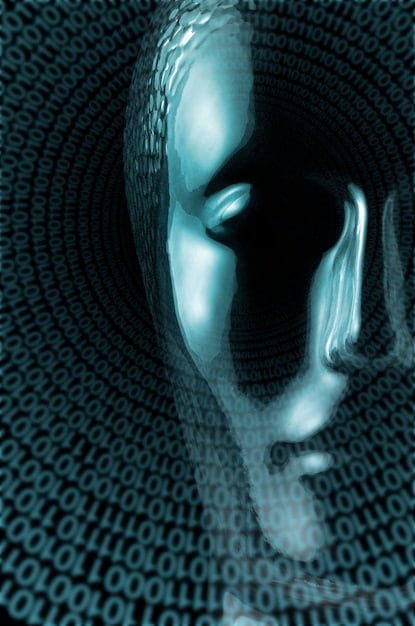AI Ethics: Deepfakes & Images – Truth Under Threat?

The Ethics of Artificial Intelligence: Are AI-Generated Images and Deepfakes a Threat to Truth and Trust in Society? explores the increasing challenges to truth and societal trust posed by AI-generated content, examining the ethical implications of deepfakes and AI-generated images in manipulating perception, spreading misinformation, and eroding the very foundation of reality.
The rapid advancement of artificial intelligence has brought forth incredible innovations, but also a Pandora’s Box of ethical dilemmas. Are the ethics of artificial intelligence: are AI-generated images and deepfakes a threat to truth and trust in society? These technologies challenge our perception of reality, blurring the lines between what is real and what is fabricated.
The Rise of AI-Generated Content
Artificial intelligence has revolutionized numerous sectors, creating content with unprecedented ease. This includes writing articles, composing music, and generating images. However, with great power comes great responsibility, and the ethical implications of AI-generated content are becoming increasingly apparent.
Understanding the Technology
AI-generated content relies on sophisticated algorithms to mimic human-created outputs. These algorithms, often based on deep learning models, can analyze vast datasets and learn to produce new, original content that closely resembles human work.
- Generative Adversarial Networks (GANs): GANs consist of two neural networks, a generator and a discriminator, that compete against each other to create increasingly realistic outputs.
- Deep Learning Models: These models use multiple layers of neural networks to analyze and generate complex patterns, enabling them to produce high-quality content.
- Text-to-Image Synthesis: This technology converts textual descriptions into visual representations, allowing users to create images from simple prompts.
The increasing sophistication of AI-generated content makes it difficult to distinguish from content created by humans, raising concerns about authenticity and trust.

Deepfakes: A Threat to Reality
Deepfakes, a type of AI-generated content, involve manipulating video or audio to replace one person’s likeness with another. This technology has raised serious ethical concerns, as it can be used to spread misinformation, damage reputations, and even incite violence.
The Dangers of Deepfakes
Deepfakes can create convincing but entirely fabricated scenarios, making it challenging for viewers to discern what is real and what is not. This capability has profound implications for politics, journalism, and personal relationships.
- Political Misinformation: Deepfakes can be used to create false narratives and manipulate public opinion, undermining the democratic process.
- Reputational Damage: Individuals can be falsely depicted saying or doing things they never did, leading to severe reputational harm.
- Erosion of Trust: The proliferation of deepfakes can erode trust in media, institutions, and even personal relationships, as people become skeptical of what they see and hear.
Combating deepfakes requires a multi-faceted approach, including technological solutions, media literacy, and legal frameworks.
In conclusion, deepfakes are a serious threat, raising complex questions about authenticity and trust in the digital age.
The Ethics of AI-Generated Images
AI-generated images, created using tools like DALL-E and Midjourney, offer incredible creative potential but also present ethical challenges. The ease with which these images can be produced raises questions about copyright, artistic integrity, and the potential for misuse.

Ethical Considerations
The use of AI to generate images raises several ethical considerations, including the potential for creating misleading or harmful content, infringing on copyright, and devaluing human creativity.
The use of AI to generate images raises several ethical considerations, including the potential for creating misleading or harmful content, infringing on copyright, and devaluing human creativity.
- Copyright Infringement: AI models are trained on vast datasets of existing images, raising questions about whether the generated images infringe on the copyright of the original creators.
- Misleading Content: AI-generated images can be used to create fake news, spread propaganda, and manipulate public opinion.
- Impact on Artists: The proliferation of AI-generated images can devalue the work of human artists and designers, potentially impacting their livelihoods.
Addressing these ethical challenges requires a thoughtful approach that balances innovation with the need to protect intellectual property and prevent misuse.
Ultimately, the ethics of AI-generated images require careful consideration to mitigate potential harm and promote responsible innovation.
The Spread of Misinformation
One of the most significant threats posed by AI-generated images and deepfakes is their potential to amplify the spread of misinformation. These technologies can create convincing but false narratives that are difficult to debunk, leading to confusion and distrust.
How Misinformation Spreads
Misinformation spreads rapidly through social media, news outlets, and other online platforms. AI-generated content can exacerbate this problem by creating highly believable fake news articles, videos, and images that can go viral before they are fact-checked.
Here’s how it typically unfolds:
- Creation: AI tools generate fake content.
- Distribution: Fake content is spread across social media and news sites.
- Engagement: People share, comment, and react, amplifying its reach.
- Impact: Misinformation influences public opinion and behavior.
Combating the spread of misinformation requires a combination of education, fact-checking, and technological solutions.
To sum it up, the blend of AI and rapid information sharing creates a perfect storm for misinformation, requiring constant vigilance and proactive measures.
Erosion of Trust in Society
The proliferation of AI-generated images and deepfakes can erode trust in institutions, media, and even interpersonal relationships. When people can no longer trust what they see and hear, the fabric of society begins to unravel.
The Consequences of Distrust
Distrust can lead to social division, political instability, and a general sense of unease. When people are constantly questioning the authenticity of information, they become more susceptible to manipulation and less likely to engage in constructive dialogue.
Several outcomes may arise:
- Social Division: Conflicting narratives widen divides.
- Political Instability: Misinformation influences elections.
- Erosion of Rational Discourse: Emotional reactions replace logical debate.
Restoring trust requires transparency, accountability, and a commitment to truth.
To summarize, AI-generated content can undermine trust, creating instability and skepticism in various facets of life.
Potential Solutions and Countermeasures
Addressing the ethical challenges posed by AI-generated images and deepfakes requires a multifaceted approach. This includes technological solutions, media literacy initiatives, legal frameworks, and ethical guidelines.
Technological Solutions
Technological solutions can help detect and identify AI-generated content, allowing users to assess its authenticity. These tools use machine learning algorithms to analyze images, videos, and audio for telltale signs of manipulation.
Strategies and Tools
- Watermarking: Adding digital signatures to content to verify authenticity.
- Reverse Image Search: Identifying the origin and spread of images.
- AI Detection Tools: Using machine learning to detect deepfakes.
However, it’s also crucial to consider policy and legal changes alongside technical tools.
The summary is that technology alone cannot solve these complex ethical and societal issues; it must be part of a larger strategy.
| Key Concept | Brief Description |
|---|---|
| 🤖 AI’s Impact | AI amplifies content creation but poses ethical dilemmas. |
| 🎭 Deepfake Risks | Deepfakes undermine trust and spread misinformation. |
| 🖼️ Image Ethics | AI-generated images raise copyright issues and misuse concerns. |
| 🛡️ Countermeasures | Solutions include tech tools and media literacy efforts. |
Frequently Asked Questions
▼
Deepfakes are AI-generated videos or audio recordings that manipulate a person’s likeness to make them appear to say or do something they never did. They can be used to spread misinformation or damage reputations.
▼
AI-generated images raise ethical issues related to copyright infringement, the creation of misleading content, and the potential devaluation of human artists’ work.
▼
AI-generated content can erode trust in media and institutions, spread misinformation, and manipulate public opinion, leading to social division and political instability.
▼
Combating AI-generated misinformation involves a multi-faceted approach, including technological solutions like watermarking and AI detection tools, as well as media literacy initiatives.
▼
Media literacy empowers individuals to critically assess the content they consume, recognize manipulated images and videos, and verify the authenticity of information before sharing it further.
Conclusion
In conclusion, the rapid advancement of AI technologies brings profound ethical implications, challenging the very foundations of truth and trust in society. Addressing these challenges will require a collaborative effort involving technologists, policymakers, educators, and the public, working together to navigate the complex landscape of AI ethics and ensure its responsible development and use.





